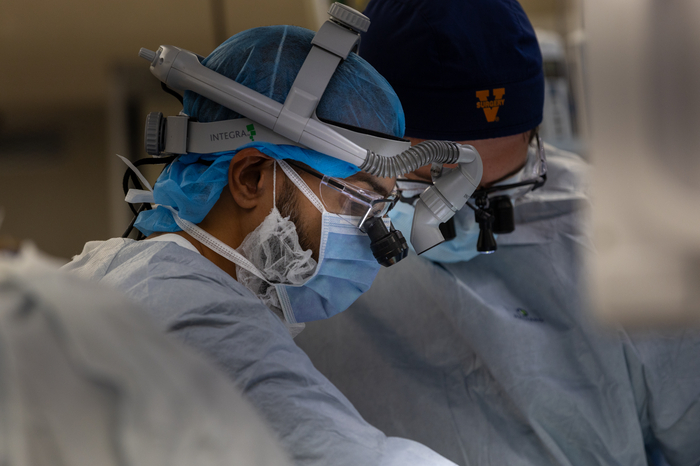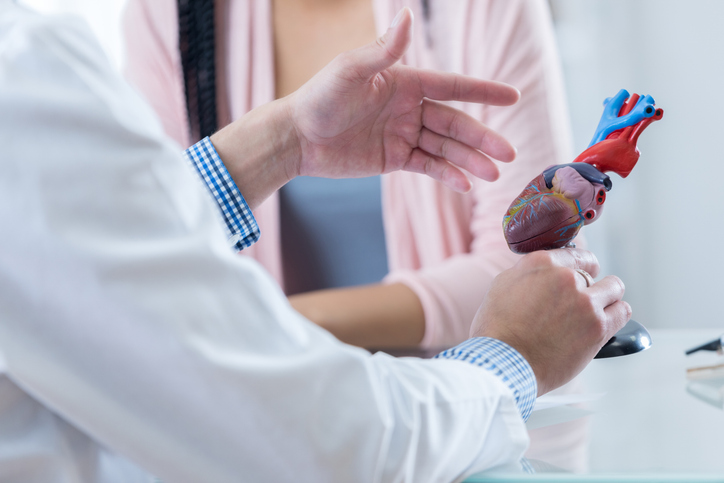Atrial Fibrillation
Atrial Fibrillation
Atrial Fibrillation
Atrial fibrillation is a heart rhythm disorder, or arrhythmia. It makes your heart beat irregularly and sometimes race. Atrial fibrillation, or A-fib, doesn't always have symptoms and may go away on its own.
But it can also lead to problems like heart failure and stroke. At Carilion Clinic, we have many ways to treat A-fib, including using the latest devices.
Atrial fibrillation is a heart rhythm disorder, or arrhythmia. It makes your heart beat irregularly and sometimes race. Atrial fibrillation, or A-fib, doesn't always have symptoms and may go away on its own.
But it can also lead to problems like heart failure and stroke. At Carilion Clinic, we have many ways to treat A-fib, including using the latest devices.
Atrial fibrillation is a heart rhythm disorder.
Your heart is a complicated electrical system. Its upper and lower chambers work together, squeezing in a rhythm to pump blood. Electrical signals from the heart set the rhythm.
Sometimes, things can go wrong in the electrical system, making your heart beat in irregular ways. With A-fib, the rhythm is off, and your heart's chambers don't work together as they should. This means that your heart doesn't pump enough blood.
Inefficient pumping can cause blood to pool in your heart, leading to blood clots. If a blood clot breaks loose, it can cause a stroke. A-fib can also weaken your heart and, over time, lead to heart failure.
What Is Atrial Fibrillation (A-Fib)?
Atrial fibrillation is a heart rhythm disorder.
Your heart is a complicated electrical system. Its upper and lower chambers work together, squeezing in a rhythm to pump blood. Electrical signals from the heart set the rhythm.
Sometimes, things can go wrong in the electrical system, making your heart beat in irregular ways. With A-fib, the rhythm is off, and your heart's chambers don't work together as they should. This means that your heart doesn't pump enough blood.
Inefficient pumping can cause blood to pool in your heart, leading to blood clots. If a blood clot breaks loose, it can cause a stroke. A-fib can also weaken your heart and, over time, lead to heart failure.
Not everyone with A-fib has symptoms. Sometimes, atrial fibrillation goes away on its own. Other people deal with it for years, and it gets worse.
A-fib symptoms include:
- Fatigue
- Feeling that your heart is racing, fluttering or pounding
- Chest pain
- Dizziness or fainting
- Shortness of breath
- Low blood pressure
What causes A-fib?
Changes in your heart's tissue and how the electric signals travel through can cause A-fib to develop.
But what causes the changes in the tissue itself? Often, it's just getting older. Aging is the leading cause of atrial fibrillation.
Other things that contribute include:
- High blood pressure: Chronic high blood pressure can cause some of these structural changes in the heart.
- Heart disease: Coronary artery disease, heart valve disease and heart failure are all linked to A-fib.
- Diabetes: Diabetes is linked closely to heart disease and can increase your risk for A-fib.
- Genetics: Researchers can't narrow down an exact gene, but family history plays a role in A-fib.
- Lifestyle factors: Smoking increases your risk for A-fib. So does heavy alcohol use.
Symptoms of Atrial Fibrillation
Not everyone with A-fib has symptoms. Sometimes, atrial fibrillation goes away on its own. Other people deal with it for years, and it gets worse.
A-fib symptoms include:
- Fatigue
- Feeling that your heart is racing, fluttering or pounding
- Chest pain
- Dizziness or fainting
- Shortness of breath
- Low blood pressure
What causes A-fib?
Changes in your heart's tissue and how the electric signals travel through can cause A-fib to develop.
But what causes the changes in the tissue itself? Often, it's just getting older. Aging is the leading cause of atrial fibrillation.
Other things that contribute include:
- High blood pressure: Chronic high blood pressure can cause some of these structural changes in the heart.
- Heart disease: Coronary artery disease, heart valve disease and heart failure are all linked to A-fib.
- Diabetes: Diabetes is linked closely to heart disease and can increase your risk for A-fib.
- Genetics: Researchers can't narrow down an exact gene, but family history plays a role in A-fib.
- Lifestyle factors: Smoking increases your risk for A-fib. So does heavy alcohol use.
At Carilion, our electrophysiologists work to understand your condition. An electrophysiologist is a cardiologist who specializes in heart rhythm problems. More importantly, we work to understand how your condition affects your life.
For some, A-fib symptoms are debilitating. We always work to improve your quality of life.
For others, the symptoms aren't the problem as much as the risk. We also want to reduce the risk of stroke and heart failure, which can impact future quality of life.
Together, we'll create an A-fib treatment plan based on your life and goals.
Atrial fibrillation treatment can include:
- Lifestyle changes: Things like quitting smoking, reducing alcohol consumption and exercising can reduce how many A-fib episodes you have.
- Medicine: Your doctor may prescribe A-fib medicines. This includes beta blockers to slow your heart rate and calcium channel blockers to slow how the lower chambers pump blood. You may also take blood thinners to prevent clots.
- Monitoring: Your doctor may have you wear a special type of heart rate monitor to learn more about your A-fib episodes.
- Cardioversion: This procedure can restore a normal heart rhythm in people with A-fib. Sometimes, we do cardioversion with medicine, but usually, we do it by sending electric shocks through electrodes on your chest.
- Ablation: Ablation uses heat to "burn" the heart tissue that's causing the A-fib. We can also do ablation with a "cryoballoon" that uses freezing energy instead of heat. Learn more about the procedures we do with cardiac catheterization.
- Pacemaker devices: In some people, a pacemaker can help control A-fib. This is usually only if you have another arrhythmia, along with A-fib.
- Closing the left atrial appendage: This minimally invasive procedure closes off a small sac in the wall of your heart. It helps prevent blood clots from forming. We use something called the WATCHMAN™ device to do this.
- Surgery: A surgery called the Maze procedure treats A-fib by creating scars in the section of the heart causing the arrhythmia. We usually only do this surgery as part of another open-heart surgery, such as surgery for coronary artery disease.
How We Treat Atrial Fibrillation
At Carilion, our electrophysiologists work to understand your condition. An electrophysiologist is a cardiologist who specializes in heart rhythm problems. More importantly, we work to understand how your condition affects your life.
For some, A-fib symptoms are debilitating. We always work to improve your quality of life.
For others, the symptoms aren't the problem as much as the risk. We also want to reduce the risk of stroke and heart failure, which can impact future quality of life.
Together, we'll create an A-fib treatment plan based on your life and goals.
Atrial fibrillation treatment can include:
- Lifestyle changes: Things like quitting smoking, reducing alcohol consumption and exercising can reduce how many A-fib episodes you have.
- Medicine: Your doctor may prescribe A-fib medicines. This includes beta blockers to slow your heart rate and calcium channel blockers to slow how the lower chambers pump blood. You may also take blood thinners to prevent clots.
- Monitoring: Your doctor may have you wear a special type of heart rate monitor to learn more about your A-fib episodes.
- Cardioversion: This procedure can restore a normal heart rhythm in people with A-fib. Sometimes, we do cardioversion with medicine, but usually, we do it by sending electric shocks through electrodes on your chest.
- Ablation: Ablation uses heat to "burn" the heart tissue that's causing the A-fib. We can also do ablation with a "cryoballoon" that uses freezing energy instead of heat. Learn more about the procedures we do with cardiac catheterization.
- Pacemaker devices: In some people, a pacemaker can help control A-fib. This is usually only if you have another arrhythmia, along with A-fib.
- Closing the left atrial appendage: This minimally invasive procedure closes off a small sac in the wall of your heart. It helps prevent blood clots from forming. We use something called the WATCHMAN™ device to do this.
- Surgery: A surgery called the Maze procedure treats A-fib by creating scars in the section of the heart causing the arrhythmia. We usually only do this surgery as part of another open-heart surgery, such as surgery for coronary artery disease.
Not only do we offer routine heart care in your neighborhood, but we're also a destination for many specialty surgeries. Carilion offers programs and new heart treatments unique to our region, drawing people from across Virginia and neighboring states.

More cardiologists in more places
With 30+ cardiologists and 30+ locations, our cardiology team is one of the largest in the region. We specialize in all areas of heart care and have the most experienced heart catheterization lab.

40+ years of heart surgery
The area's largest and most experienced heart surgery program, we were the first to offer open-heart surgery. We also do more than 5,000 minimally invasive heart procedures every year.
Why Choose Carilion Clinic?
Not only do we offer routine heart care in your neighborhood, but we're also a destination for many specialty surgeries. Carilion offers programs and new heart treatments unique to our region, drawing people from across Virginia and neighboring states.
Patient Stories
This is a wonderful thing that they have come up with."
Health and Wellness

Lifestyle Medicine: Positive Changes, Powerful Results

Decisions, Decisions: How To Choose Your Heart
Get Care at Carilion Clinic
Your path to better health starts here. Explore comprehensive care options and find the support you need for every step of your wellness journey.
Get Care at Carilion Clinic
Your path to better health starts here. Explore comprehensive care options and find the support you need for every step of your wellness journey.
Get Care at Carilion Clinic
Your path to better health starts here. Explore comprehensive care options and find the support you need for every step of your wellness journey.
Get Care at Carilion Clinic
Your path to better health starts here. Explore comprehensive care options and find the support you need for every step of your wellness journey.

